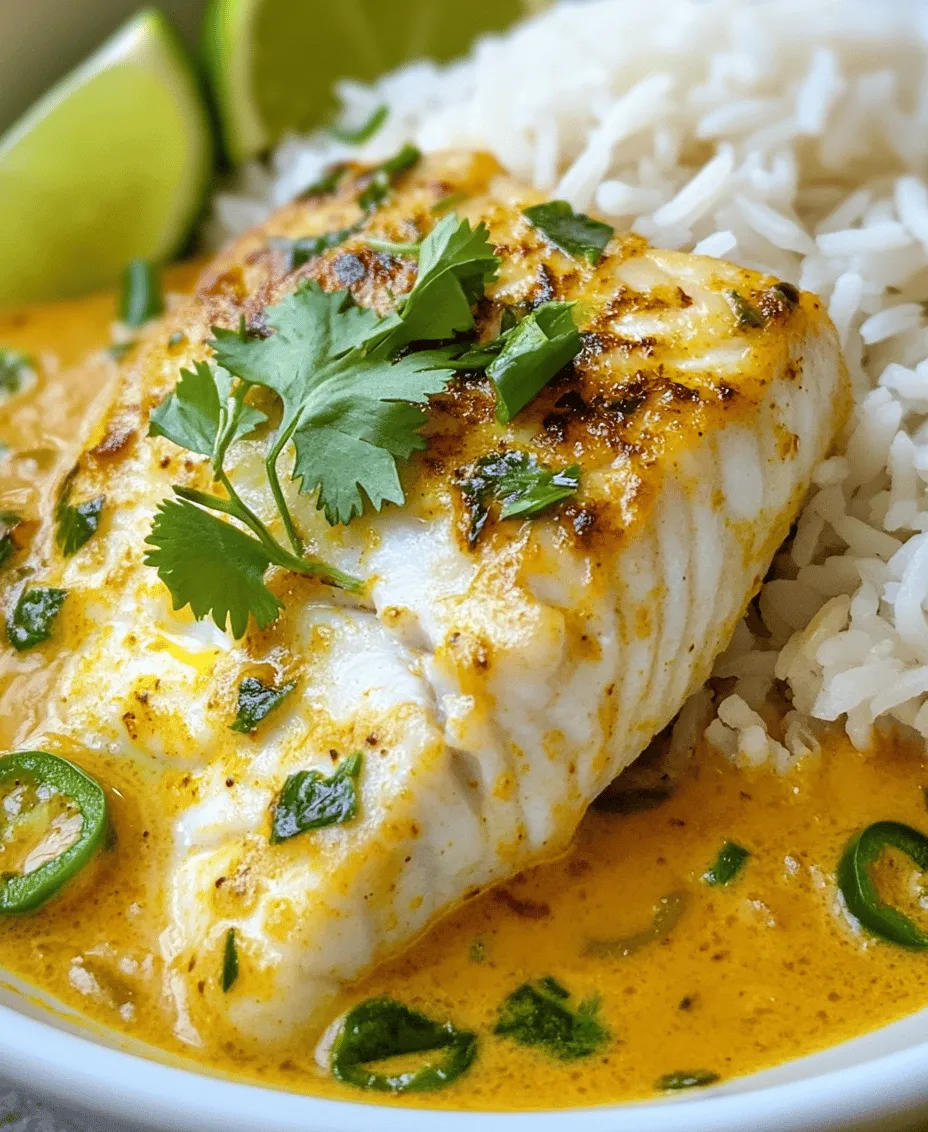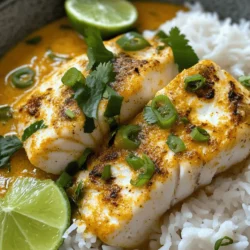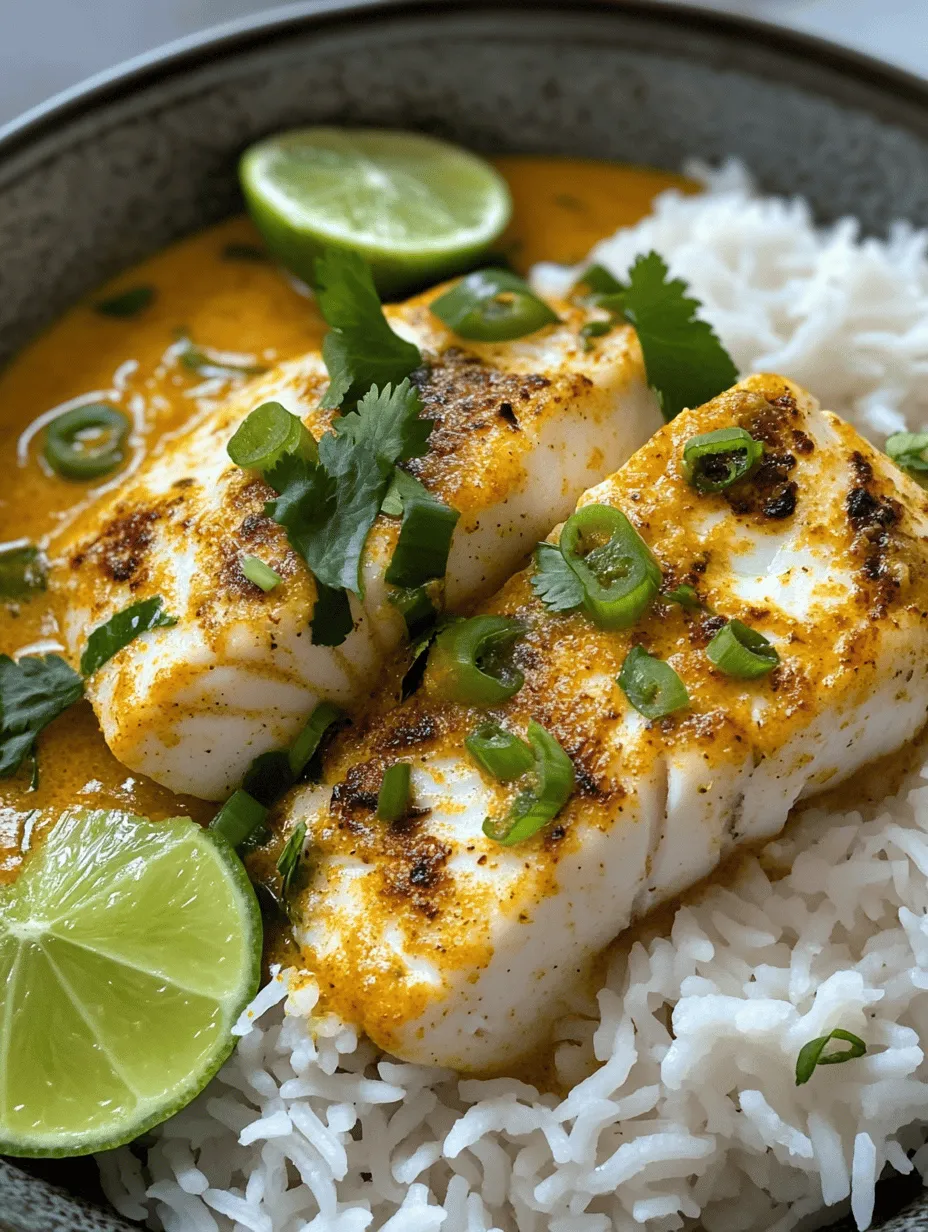Introduction
Welcome to the vibrant world of tropical cuisine! Today, we invite you to explore the rich and aromatic flavors of Coconut Fish Curry with Lime and Lemongrass. This dish is not just a meal; it’s an experience that brings the exotic essence of Southeast Asia right into your kitchen. With its bright and fragrant ingredients, this curry is a feast for the senses, offering a perfect blend of creamy coconut milk, fresh fish, and zesty lime.
Coconut fish curry is incredibly easy to prepare, making it an ideal option for both a quick weeknight dinner and an impressive dish to serve at a gathering. Imagine sitting down to a bowl of this delicious curry, the aroma wafting through your home, warming your heart and tantalizing your taste buds. It’s a dish that brings comfort while also providing a taste of the tropics, making it a beloved choice for many.
The beauty of coconut fish curry lies in its simplicity and versatility. With just a handful of ingredients, you can create a dish that is not only satisfying but also bursting with flavor. The combination of coconut milk and fresh herbs creates a rich, velvety sauce that perfectly complements the tender fish. Whether you’re a seasoned cook or a beginner in the kitchen, this recipe will guide you through each step to ensure a delightful culinary adventure.
Understanding Coconut Fish Curry
Coconut fish curry has deep roots in Southeast Asian cuisine, particularly in countries like Thailand and Malaysia, where fresh seafood and aromatic herbs are staples. This dish reflects the region’s culinary traditions, showcasing the use of coconut milk as a base for many curries. The creamy texture of coconut milk pairs beautifully with the delicate flavors of fish, creating a harmonious balance that is both comforting and refreshing.
The cultural significance of this dish cannot be overstated. It embodies the ethos of tropical cooking, where fresh, local ingredients are celebrated and transformed into something extraordinary. Families often gather around a pot of curry, sharing stories and laughter, making it a dish that is synonymous with togetherness and warmth. In coastal regions, fishermen often prepare this curry with the daily catch, exemplifying the connection between the land and the sea.
As you venture into making coconut fish curry, you’ll discover that there are numerous variations across different regions. Some recipes may include additional vegetables, while others might introduce unique spices, reflecting local tastes and traditions. Regardless of the variation, this recipe aims to bring you the authentic flavors and comforting essence of coconut fish curry, allowing you to enjoy a taste of the tropics from the comfort of your home.
Ingredient Breakdown
To create a truly memorable coconut fish curry, it’s essential to select high-quality ingredients that will enhance the flavor profile of the dish. Here’s a breakdown of the key ingredients that define this recipe:
Firm White Fish Fillets
The star of this curry is undoubtedly the fish. Choosing the right type of fish is crucial for achieving the best texture and flavor. For this recipe, firm white fish fillets such as cod, snapper, or halibut are ideal. These varieties hold up well during the cooking process and absorb the flavors of the curry beautifully. Moreover, they are packed with lean protein and omega-3 fatty acids, making them a healthy addition to your diet.
Coconut Milk
Coconut milk is the heart of this curry, providing a rich and creamy base that elevates the dish to new heights. It not only adds a delightful sweetness but also enhances the overall texture, making the curry luscious and smooth. Beyond its culinary benefits, coconut milk is known for its health advantages; it’s rich in vitamins, minerals, and healthy fats. Additionally, it’s a great dairy-free option, making this dish suitable for various dietary preferences.
Aromatics
Aromatics play a pivotal role in building the flavor foundation of any curry, and this recipe is no exception. Onions, garlic, and ginger are sautéed to release their natural oils and flavors, creating a fragrant base that enhances every bite. Onions add sweetness and depth, garlic brings a pungent kick, and ginger contributes a warm, spicy note that brightens the entire dish.
Lemongrass and Green Chilies
To achieve the signature tropical freshness of this curry, lemongrass and green chilies are essential components. Lemongrass imparts a citrusy flavor that pairs perfectly with the richness of coconut milk, while green chilies add just the right amount of heat. The combination of these ingredients creates a vibrant and aromatic profile that is refreshing and invigorating.
Citrus Elements
Lime zest and juice are crucial for balancing the flavors in coconut fish curry. The acidity from lime cuts through the richness of the coconut milk and enhances the overall taste. Lime not only adds brightness but also complements the fish beautifully, ensuring that each bite is a burst of flavor. Using fresh lime juice and zest will elevate your curry, making it truly unforgettable.
Fish Sauce and Brown Sugar
To round out the flavor profile, fish sauce and brown sugar are added. Fish sauce provides an umami depth that enhances the overall taste of the curry, while brown sugar adds a subtle sweetness that balances the dish. Together, these ingredients work harmoniously to create a well-rounded flavor that is both savory and slightly sweet.
Preparation Steps for Coconut Fish Curry
Now that you’re familiar with the essential ingredients, let’s dive into the preparation steps for creating this delightful coconut fish curry. Each step is designed to build flavor and ensure that the dish is perfectly balanced.
Preparing the Aromatics
The first step in creating your coconut fish curry is to prepare the aromatics. Start by finely chopping the onion, garlic, and ginger. The key to unlocking their flavors is to sauté them in a pan over medium heat. Use a splash of oil to coat the bottom of the pan, then add the onions first. Cook until they are translucent, which usually takes about 5 minutes. This step is crucial, as it lays the foundation for the flavor of the entire dish.
Once the onions are softened, add the minced garlic and ginger. Stir them in and cook for an additional minute, just until they become fragrant. Be careful not to let them burn, as this can impart a bitter taste to your curry. The timing of this step is essential—the goal is to release the natural oils and aromas without overcooking.
Building Flavor
After the aromatics have been sautéed, it’s time to build the flavor of your curry. This involves adding the lemongrass, green chilies, and any spices you may wish to include, such as turmeric or coriander. These ingredients will enhance the aromatic profile and add depth to the dish.
Next, pour in the coconut milk, stirring gently to combine everything. As the coconut milk heats up, it will begin to meld with the flavors you’ve developed, creating a rich and inviting base. Allow this mixture to simmer for a few minutes, letting the flavors infuse together. It’s essential to keep the heat at a medium-low level; you want the mixture to be hot but not boiling vigorously, as this can cause the coconut milk to separate.
Creating the Coconut Broth
With the flavors well incorporated, it’s time to create the coconut broth that will envelop your fish. Add the fish sauce, brown sugar, lime juice, and lime zest to the coconut milk mixture. This combination of ingredients is what will deliver that signature taste of coconut fish curry—sweet, savory, and slightly tangy.
Stir everything together thoroughly, allowing the broth to simmer for another 5 minutes. This step is crucial, as it allows the flavors to marry and develop further. Taste the broth and adjust the seasoning if necessary, adding more lime juice or fish sauce to suit your palate. It should be vibrant and full of character, setting the stage for the fish to shine.
As you prepare the curry, your kitchen will fill with enticing aromas, promising a delicious meal ahead. Stay tuned for the next steps, where we will guide you on how to introduce the fish and finish this delightful dish!

Cooking the Fish
When it comes to cooking the fish in your Coconut Fish Curry, the key is to achieve a tender texture without breaking apart the delicate fillets. To begin, ensure that your fish is fresh, which not only enhances the overall flavor but also contributes to a firmer texture during cooking. If you’re using frozen fish, make sure to thaw it completely and pat it dry with paper towels to remove excess moisture.
Once your curry base is ready, gently slide the fish fillets into the simmering sauce. It’s best to place the fish in the pan in a single layer, allowing enough space between each piece to prevent them from sticking together. As the fish cooks, it will naturally begin to flake. To avoid breaking the fillets apart, resist the urge to stir the curry too vigorously. Instead, use a spoon to gently baste the fish with sauce, ensuring even cooking while maintaining its integrity.
Cook the fish for about 5 to 7 minutes, depending on the thickness of your fillets. You’ll know it’s done when the flesh becomes opaque and flakes easily with a fork. If using thicker pieces, you may need to extend the cooking time slightly; just be careful not to overcook, as this can lead to a dry texture.
Finishing Touches
Once the fish is fully cooked, it’s essential to let the dish sit for about 5 to 10 minutes off the heat. This resting period allows the flavors to meld beautifully and gives the sauce time to thicken slightly. While the curry rests, you can prepare your garnishes. Fresh cilantro is a classic addition that not only provides a vibrant color contrast but also elevates the dish with its refreshing taste. Lime wedges are another essential garnish; they add a zesty brightness when squeezed over the curry just before serving.
Serving Suggestions
Steamed Jasmine Rice
Coconut Fish Curry is traditionally served with steamed jasmine rice, which complements the dish perfectly. The fragrant, sticky rice absorbs the rich curry sauce, creating a delightful balance of flavors. To prepare jasmine rice, rinse it under cold water until the water runs clear to remove excess starch. Cook it in a ratio of 1 cup of rice to 1.5 cups of water, bringing it to a boil before lowering the heat and simmering with a lid on for about 15 minutes. Fluff the rice with a fork before serving alongside your curry.
Garnishing
The visual appeal of a dish can elevate the dining experience, and garnishing plays a crucial role in this. A sprinkle of fresh cilantro not only enhances the aroma but also adds a pop of green to your plate. Pairing it with lime wedges allows guests to customize their flavor, adding a sharp tang that cuts through the richness of the coconut milk.
Beverage Pairings
To complete your meal, consider pairing Coconut Fish Curry with beverages that enhance its tropical essence. Light beers, such as lagers or wheat beers, provide a refreshing contrast to the curry’s creaminess. Alternatively, tropical juices like pineapple or passion fruit juice can complement the flavors while providing a sweet, fruity balance. For a non-alcoholic option, a coconut water spritzer with a hint of lime would be a delightful accompaniment.
Nutritional Benefits of Coconut Fish Curry
Fish
The main protein source in Coconut Fish Curry is fish, which is an excellent source of lean protein. Fish is rich in omega-3 fatty acids, which are essential for heart health, brain function, and reducing inflammation. Varieties such as salmon or mackerel are particularly high in these beneficial fats.
Coconut Milk
Coconut milk is another star ingredient in this dish, known for its creamy texture and unique flavor. It contains medium-chain triglycerides (MCTs), which are easily digestible fats that can provide a quick source of energy. Additionally, coconut milk is rich in vitamins C, E, and several B vitamins, contributing to overall health. Its natural sweetness balances the spices in the curry, making it a delightful addition.
Vegetables and Herbs
The vegetables and herbs used in Coconut Fish Curry not only provide flavor but are also packed with vitamins and antioxidants. Lemongrass and ginger, key aromatics in the recipe, are known for their anti-inflammatory properties, while cilantro adds a burst of flavor and is rich in vitamins A and K. The addition of lime juice not only enhances flavor but is also high in vitamin C, contributing to a healthy immune system.
Variations and Adaptations
One of the best aspects of Coconut Fish Curry is its versatility; you can easily customize the recipe to suit your preferences.
Substituting Proteins
If you prefer seafood variations, shrimp makes for a fantastic substitute. Its quick cooking time and sweet flavor complement the coconut curry beautifully. For a vegetarian or vegan option, consider using tofu or tempeh. Both can absorb the flavors of the curry and provide a satisfying protein source.
Adjusting Spice Levels
Spice levels can be tailored to your taste. If you enjoy a milder dish, consider reducing the number of chilies or removing the seeds from the chilies before adding them to the curry. Conversely, if you prefer more heat, feel free to increase the amount of fresh or dried chilies.
Adding Vegetables
Incorporating seasonal vegetables is another great way to customize your Coconut Fish Curry. Vegetables like bell peppers, snap peas, or zucchini can add color and nutrition. Simply chop them into bite-sized pieces and add them to the curry along with the fish, allowing them to cook until tender.
Conclusion
Embracing the culinary adventure of making Coconut Fish Curry with Lime and Lemongrass is a rewarding experience that brings a taste of the tropics to your kitchen. This dish not only showcases the delightful fusion of flavors but also offers a range of nutritional benefits, making it a wholesome choice for any meal. Its versatility allows for numerous adaptations, whether you’re catering to dietary preferences or simply looking to mix things up with seasonal ingredients.
As you savor each bite of this aromatic curry, the combination of tender fish, creamy coconut, and zesty lime will transport you to sun-kissed shores. So, gather your ingredients, unleash your creativity, and enjoy the process of bringing this tropical delight to life. Your taste buds will thank you, and your dinner guests will be eager for seconds!


